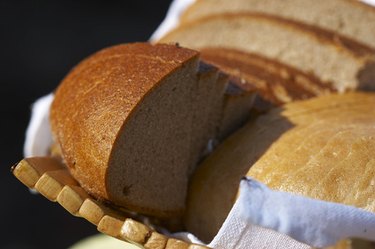Things You'll Need
Favorite bread recipe
Bread recipe ingredients
100 percent wheat bran
Oven mitts
Wire cooling rack

If you have a favorite bread recipe, but only wish it had more fiber in it, changing it to suit your needs is simple. All bread baking relies on a ratio of two to one with regard to flour vs. moisture. To add more fiber, which is dry like flour, you must substitute it for some of the flour specified in the recipe. Salt, yeast and sugar specified in bread recipes are there not only for flavoring, but for the chemical reactions they produce in order to make your bread rise correctly, so they cannot be substituted.
Step 1
Read your favorite bread recipe through entirely, even if you have made it many times before. It is important that you understand exactly what goes into each part of making the bread.
Video of the Day
Step 2
Substitute 1/4 to 1/2 cup of the flour specified in the recipe with an equal amount of bran. Add the bran to the recipe at the same time as you add the flour. The less bran you add, the more similar to normal your bread's texture will be, but the fiber content will be lower.
Step 3
Mix all ingredients together in the order and method specified by the recipe. Watch the dough to see whether it is too dry and crumbly, or too moist and sticky.
Step 4
Sprinkle in 1 tbsp. of flour at a time if the bread is too moist, or 1 tsp. of water at a time if the dough is too dry. Keep mixing after each addition, and observe any changes to the dough. Bread dough -- unless otherwise described by your recipe -- should generally be smooth and elastic when it is the right consistency.
Step 5
Bake bread as the recipe directs. Wearing an oven mitt on one hand, turn the bread over and lightly tap its bottom with the bare knuckles of your other hand. If it sounds hollow, it is done, and is ready to cool on a wire-cooling rack before serving.
Step 6
Give the bread five more minutes in the oven if it is not done the first time, and another five if it is not done the second time. Watch the bread closely at this point, so it does not overbake and get too hard.
Tip
If you find that your first loaf of high-fiber bread does not rise as much as you hoped, try using bread flour instead of all-purpose flour, and boosting the yeast amount by 1/4 tsp.
Bran can be used in flaked or cereal form, if you have it on hand. Additionally, oatmeal or chopped dates in the same ratio make a good high-fiber substitute. Be aware that more moisture may be required, depending on how dry your fiber source is, as well as how dry the air is when you make the bread.
Some fruits contain high amounts of fiber as well, but in order to preserve the balance of moisture to dry ingredients, choose dried fruits for breads. You may want to reserve use of fruit for sweeter breads made with rich doughs for better flavor. Rich bread dough may contain milk, butter, and/or eggs.
Video of the Day